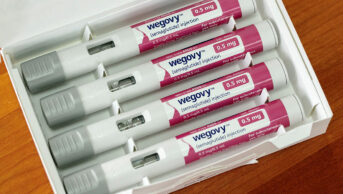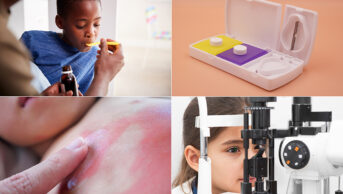Abstract
Aim
To assess the prevalance of parent-reported drug allergy and determine whether the reported allergy had a confirmed diagnosis
Design
Examination of drug charts over a one-month period, followed by interview
Subjects and setting
A paediatric population in a London children’s hospital
Results
Of the 729 charts reviewed, 670 of the drug allergy boxes (92%) were completed, and the recorded drug allergy prevalence was 8% (55/670). Of those drug allergies recorded, 74.5% (41/55) were due to antibiotics, 9%(5/55) to local anaesthetics, and 3.6% (2/55) due to non-steroidal anti-inflammatory drugs and to anticonvulsants.
Conclusion
Only 5% of the children had any formal investigation of their drug allergy, suggesting a potential overestimate by parents of the prevalence of drug allergy with greater than necessary impact on prescribing.
Introduction
Adverse drug reactions and allergies to medicines are grist to the mill of the popular media. For example, according to a report by the BBC, “around 15 per cent of hospital patients in the UK report adverse reactions to medication, but less than 5 per cent are true allergies. Of this 5 per cent, less than 1 per cent are fatal.”[1]
Also according to a BBC report of some research, “patients are being put at risk because their drug allergies are not flagged up by hospital staff”[2]
.
Adverse drug reactions (AdRs) are noxious or unintended responses to a drug that occur at a dose normally used by humans[3]
.
A total of 964 UK patients are reported to have died because of suspected drug reactions in 2006 — over 200 after lengthy stays in hospital. This represents a 45 per cent increase in the number of reported AdRs over the course of a decade[4]
.
A drug allergy is an immunologically mediated AdR characterised by specificity and recurrence on re-exposure. Self- or parent-reported drug allergy is common in daily clinical practice. It is widely acknowledged that the true burden of allergy to drugs is overestimated[4],[5]
. Over-reporting of drug allergy may result from confusion owing to an overlap of symptoms with those of non-immunological AdRs, or with the condition that the drug has been prescribed to treat. This is best illustrated in the reporting of allergy to beta-lactams, which are the commonest cause of true drug allergy[6]
.
The use of penicillins for children during what are often viral infections can result in a rash that in reality is due to the infection but is sometimes perceived an allergic reaction to the drug. Parents also often report what they think is a drug allergy in their children based on some past incident, but the likelihood of true allergy in such cases often cannot be based on a confirmed clinical history. These problems are compounded by the underprovision of specialist allergy services in the UK to investigate whether or not true drug allergy is present.
A missed or incorrect diagnosis of drug allergy can have serious consequences. Overdiagnosis can put the patient at risk of a less effective or more harmful drug, and at a population level there are implications for healthcare costs and antibiotic resistance.
Most epidemiological data relating to drug allergy prevalence are in adults, with few data available in paediatric populations. To our knowledge, there are currently no UK-based paediatric data on this topic.
The aim of our study was to establish the prevalence of parent-reported drug allergy in a UK paediatric population, the drugs most commonly implicated and whether the suspected allergy was further investigated to confirm diagnosis.
Methods
A prospective observational study was conducted over one month in 2008 at the Evelina Children’s Hospital, a London paediatric teaching hospital (140 beds and 40 neonatal cots) that forms part of Guy’s & St Thomas’ NHS Hospitals Foundation Trust.
The study involved a review of the prescription charts of all children admitted to the wards in order to identify whether the allergy boxes on drug charts had been properly completed and signed by a doctor, nurse or pharmacist and the allergies recorded. The information on the allergy box is currently retrieved by health professionals directly from parents or carers, or from medical notes.
This review was followed by a short structured interview with the families of children reporting drug allergies to ascertain the nature of the reported reaction and details of how the diagnosis was reached.
Official procedures for conducting audits in the trust were followed and relevant permission and registration of the audit obtained. Parental consent was sought for participation in interviews.
Results
Over the one-month period, 729 patients’ drug charts were reviewed in all wards (paediatric surgical, general paediatrics, neurology, cardiology, nephrology, paediatric intensive care and neonatology) at the children’s hospital. We ascertained that 670 of the drug allergy boxes (92 per cent) were completed and signed. Of these, a further 615/670 (92 per cent) stated “no known allergy”. The drug charts stated that the patient had a drug allergy in 55/670 (8 per cent). The median age of those with drug allergies recorded in the drug chart was seven years (interquartile range 4.25–12) and 47 per cent were boys. Recorded allergy rates varied between specialties with 17/212 (8 per cent) in general paediatrics, 11/118 (9.4 per cent) in neurology/cardiology, 24/214 (11.2 per cent) in nephrology and 3/66 (4.5 per cent) in paediatric intensive care. No allergies (0/75) were recorded in the neonatal unit.
Of the 55 children with recorded allergies, 41 (74.5 per cent) were reportedly due to an antibiotic, five (9 per cent) to a local anaesthetic, two (3.6 per cent) to a nonsteroidal anti-inflammatory drug and two (3.6 per cent) to an anticonvulsant. Five children (9 per cent) reported being allergic to a drug that could not be classified in any of the above groups (eg, omeprazole, ketamine, atropine eye drops, cough syrup containing codeine).
Among those with an antibiotic allergy recorded, “penicillin” was the most commonly implicated (4 per cent of all children and 73 per cent [30/41] of all antibiotics), followed by macrolides (15 per cent [6/41]) and vancomycin (10 per cent [4/41]).
Seventy per cent of children (21/30) with penicillin allergy had required an alternative antibiotic and of these, 33 per cent (7/21) received a penicillin or cephalosporin antibiotic (amoxicillin, flucloxacillin or cephalexin) without any reaction (see Table 1). On investigation of other drugs, such as benzodiazepines, two patients allergic to diazepam were given lorazepam, which was tolerated.
| Table 1: Alternative antibiotics used by patients allergic to penicillin | |
| Antibiotic | Percentage |
| Erythromycin | 47.0 |
| Amoxicillin | 15.0 |
| Flucloxacillin | 9.5 |
| Clarithromycin | 9.5 |
| Cephalexin | 9.5 |
| Other | 9.5 |
Structured interviews with families revealed that 11 per cent of children with a reported drug allergy (6/55) reported two or more drug allergies and 40 per cent (22/55) were reported as having an allergy to a drug they had reacted to more than five years ago. A total of 89 per cent (49/55) had been diagnosed by either a gP or a paediatrician and one of them also by a dermatologist. However, only 5 per cent (3/55) had allergy tests performed to support the diagnosis.
During the interviews a diverse range of symptoms was reported to be due to penicillin: 75 per cent (23/30) described a rash (blotchy, red and itchy, with or without swelling); others described gastrointestinal symptoms (14 episodes of diarrhoea, vomiting, abdominal pain and constipation) following a dose of penicillin. There were also descriptions of urticaria (six episodes), fever, breathlessness, headache, facial swelling, convulsions, anaphylactic shock and even stevens Johnson syndrome (one episode of each). There was only one patient who reported anaphylactic shock to penicillin.
The main route of administration of drugs causing the allergies was oral (73.6 per cent, 40/55) followed by parenteral (15 per cent, 8/55). thirty-one per cent (17/55) suffered from an atopic disorder, 56 per cent (30/55) had a family history of allergic disease, and 25 per cent had an atopic disease and family history.
Discussion
AdRs, including drug allergies, are a considerable burden on the nHs, accounting for one in 16 adults hospital admissions, at a cost of up to £466m a year[7]
.
Most data relating to prevalence of drug allergy are from adult studies. to our knowledge, this is the first study in the literature in a Uk-based paediatric population. A literature search revealed few studies looking at prevalence of drug allergies in children attending hospital. In a Portuguese-French collaborative crosssectional survey of 1,426 children attending a general paediatric outpatient clinic, a 10.2 per cent prevalence of self-reported AdRs was found; from these drug allergy was reported in 6.0 per cent[8]
.
A German study aimed to assess the prevalence of parent-reported drug allergy in a german paediatric university hospital via questionnaire-based survey[9]
. The researchers recorded a lifetime-prevalence of AdRs at 7.5 per cent, with 4.2 per cent (61/1,447) suggestive of an allergic mechanism.
In our observational study, we found that the prevalence of parent-reported drug allergy in children under 16 years of age was 8 per cent, with 4.4 per cent due to penicillin alone. Many patients, including 33 per cent of penicillin allergic children, were given closely related drugs which they tolerated, strongly suggesting that the initial drug allergies were over-diagnosed.
The proportion of children suffering from an atopic disorder is consistent with that reported in the wider paediatric population which may suggest that drug allergy does not have preponderance in atopic populations[10]
.
The drugs most commonly implicated in AdRs were antibiotics, mostly beta-lactams, local anaesthetics, NSAIDs and anticonvulsants, which was consistent with other paediatric studies[8],[9]
.
Our results indicate that drug allergies are commonly reported but the lack of allergy specialist evaluation and testing has likely led to an overestimation of the problem. As a result, unnecessary use of alternative medicines is required. Furthermore, even those reporting allergies are sometimes given closely related medicines that may well cause harm in true allergy, suggesting more effective reporting mechanisms are required.
Our findings that only a tiny proportion of patients receive any formal specialist evaluation of their possible drug allergy will inevitably mean that insecure diagnoses will continue to be made. At best, this will lead to the unnecessary expense of using second line medication and, at worst, result in accidental, potentially life-threatening reactions.
The under-provision of specialist allergy services, including drug allergy diagnostic services, has been well recognised within the Uk by both physicians and government agencies[11],[12]
. Currently, comprehensive drug allergy assessment is available at only a small number of tertiary centres[13]
. However, the development of national care pathways by the Royal College of Paediatrics and Child Health now provides an algorithm with the stages of ideal care and a set of competences required to diagnose, treat and optimally manage drug allergy[14]
. It is expected that this will go some way towards improving current service provision.
About the authors
Sara Arenas-López is consultant pharmacist, paediatric critical care, Lauri-Ann Van der Poel is paediatric specialist registrar, Gideon Lack and George du Toit are consultant physicians in paediatric allergy and Adam Fox is consultant physician and honorary senior lecturer in paediatric allergy, all at Evelina Children’s Hospital, Guy’s and St Thomas’ Hospital NHS Foundation Trust, King’s Health Partners.
Correspondence to: Adam Fox (email adam.fox@gstt.nhs.uk)
Acknowledgements
We thank Fatema Bharwani, pharmacy student, for her help with data collection.
References
[1] Morris A. Drug allergies. 2012. Available at: www.bbc.co.uk/health (accessed July 2012).
[2] BBC News. Hospital unaware of allergies. 10 September 2007. Available at: news.bbc.co.uk/1/hi/health/6983290.stm (accessed July 2012)
[3] Edwards IR & Aronson JK. Adverse drug reactions: definitions, diagnosis, and management. Lancet 2000;356:1255–1259.
[4] Drug reactions kill thousands. 27 December 2007. Available at: news.bbc.co.uk/1/hi/7161196.stm (accessed July 2012).
[5] Gomes ER & Demoly P. Epidemiology of hypersensitivity drug reactions. Current Opinion in Allergy and Clinical Immunology 2005;5:309–316.
[6] Bousquet PJ, Pipet A, Bousquet-Rouanet & Demoly P. Oral challenges are needed in the diagnosis of ß-lactam hypersensitivity. Clinical and Experimental Allergy 2008;38:185–190.
[7] Pirmohamed M, James S, Meakin S et al. Adverse drug reactions as cause of admission to hospital: prospective analysis of 18,820 patients. BMJ 2004;329;15–19.
[8] Rebelo Gomes E, Fonseca J, Araujo L et al. Drug allergy claims in children: from self reporting to confirmed diagnosis. Clinical and Experimental Allergy 2007;38:191–198.
[9] Lange L, Koningsbruggen SV & Rietschel E. Questionnaire-based survey of lifetimeprevalence and character of allergic drug reactions in German children. Pediatric Allergy and Immunology 2008:19;634–638.
[10] Anandan C & Sheikh A. Preventing development of allergic disorders in children. BMJ 2006;333:485.
[11] Royal College of Physicians. Allergy: the unmet need. A blueprint for better patient care. Report of a working party. London: RCP; 2003.
[12] Report of the House of Lords Science and Technology Committee on Allergy. 6th report of Session 2006–07. London: Stationery Office; 2007.
[13] Royal College of Physicians. Allergy services: still not meeting the unmet need. London: RCP; 2010.
[14] du Toit G, Lloyd K, Sinnott L et al. The RCPCH care pathway for children with drug allergies: an evidence and consensus based national approach. Archives of Disease in Childhood 2011;96(Suppl 2):i15–18.


